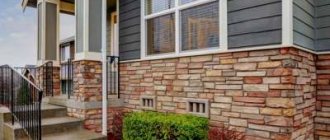Are you planning to add siding to your home, but find that the gas pipe is too close to the wall? Natural gas is a dangerous substance, and it is not for nothing that all work related to it is strictly regulated. Agree, you don’t need any problems with the gas service or the threat of an explosion after finishing.
Every year, dozens of people die from explosions and fires of domestic gas, and hundreds more lose their homes. In most cases, the cause of the tragedy is an incorrectly performed re-equipment. If everything is done according to the instructions, the fresh facade will not only be beautiful, but also safe.
Representatives of the gas service do not care about the beauty of the facade of your house; their demands are justified only by safety. We will tell you about compromise options on how to cover a gas pipe with siding, in which the result will meet all standards and look aesthetically pleasing. At the same time, we’ll figure out what standards exist and what demands of gas workers are legitimate.
When will a pipe interfere with siding?
Before figuring out how to solve a problem, it’s worth finding out whether it applies specifically to your situation. The gas pipeline can create problems when covering a house with siding only when it runs along the wall of the building.
In addition, if you are sheathing a house without insulation, with sheathing of minimal height or without it at all, the existing gap between the wall and the pipe may be quite sufficient for you, and you will not need to do anything with it.
The pipe will become a hindrance if it is already located at a distance of no more than 6 - 7 cm from the wall, and also if there are already violations in its location at the moment. Another reason for replacing a pipe, and at the same time for its displacement, may be its wear and tear - for example, rusty spots that threaten a gas leak.
Distance from the house to the object outside the fence
When deciding on the placement of a house on a site, they also take into account the distance of the future building to power lines, gas pipelines, railways and cemeteries. This will protect households from traffic noise and fumes from burial sites, and avoid flooding and subsidence of a private building located on excessively wet soil.
Before power lines
To protect the population from electric shock due to accidental deformation of wires, security zones are established on both sides of power lines. Within these areas, housing construction and the construction of dacha and gardening partnerships are prohibited. If a house does end up within the power line, it is not demolished, but a ban on reconstruction and capital construction is imposed.
The minimum distance from the house to the power line depends on its voltage
Compliance with power line security zones also ensures the safety of the electrical network section from fluctuations that occur during the construction of a house. The safe distance from the fence to power lines is determined based on the voltage level and is:
- 35 kV – 15 m;
- 110 kV – 20 m;
- 220 kV – 25 m;
- 500 kV – 30 m;
- 750 kV – 40 m;
- 1150 kV – 55 m.
To the pond
When dreaming of a house near a river or pond, you need to determine whether the purchased plot is included in a water protection zone - land adjacent to a water body with special legal protection. The establishment of a special regime is aimed at preventing pollution, siltation and salinization of the soil, preserving the richness of waters and maintaining the natural biocenosis.
The minimum distance from the house to the river depends on the type of reservoir
Building a house near a pond also carries the risk of its destruction due to its placement on softened soil. When laying the foundation, the width of the water protection zone of a river or sea is taken into account. This territory is determined by the length of the reservoir and is:
- 10 km – 50 m;
- up to 50 km – 100 m;
- over 50 km – 200 m;
- for the sea - more than 500 m.
To the gas pipe
If there is an external gas pipeline on the site, the distance between it and the house must be at least 2 m. The safety distance for underground pipes is determined based on the gas supply pressure. Within populated areas, as a rule, the pressure in the gas pipeline does not exceed 0.005 MPa. In this case, the foundation is laid at a distance no closer than 2 m from the gas pipe.
In the village, a distance of 2 m is sufficient to the low-pressure gas pipe
To the road
In different settlements, the distance between the fence and the road varies. In small villages, as a rule, this figure should be at least 3 m. If the local administration has allowed to deviate from the standards, it is still better to build a fence away from the passage. This will not only protect residents, but also make it easier to access the site.
It is better to stay away from the dust and smells of the road: at least five meters from the fence
When talking about the distance between the fence and the road, the concepts of “road” and “roadway” are distinguished. The first is called a roadbed with a pedestrian zone and a roadside, the optimal distance to which is about 3 m. The second is considered an area for the movement of vehicles. If the land plot is located near highways, the distance to the fence should be at least 5 m.
To the cemetery
The norm for the distance from a cemetery with an area of more than 20 hectares to a residential building is at least 500 m. If the site is located in a village near a small cemetery, the dwelling should be located at least 300 m away from it. For columbariums, memorial complexes, closed burial places, the permissible the distance to the home is 50 m.
The minimum distance to the cemetery is determined by its size
To the railway
The noise and smell from the railway will not please anyone: we are building a house no closer than 100 m
To protect land owners from train noise, the distance from the private sector to the railway must exceed 100 m. If the railway track is located in a depression, or the carrier company has taken measures to ensure noise protection (installed noise barriers, fences), it is permissible to build a house near the tracks, but not closer than 50 m.
We hope that the recommendations outlined will help you make the right choice of placing a house on your own site. In any case, it is better to make sure it is correct by discussing your plans with the local administration and neighbors. Author of the text: Miroshnikov A.P.
When will a pipe interfere with siding?
Before figuring out how to solve a problem, it’s worth finding out whether it applies specifically to your situation. The gas pipeline can create problems when covering a house with siding only when it runs along the wall of the building.
In addition, if you are sheathing a house without insulation, with sheathing of minimal height or without it at all, the existing gap between the wall and the pipe may be quite sufficient for you, and you will not need to do anything with it.
The pipe will become a hindrance if it is already located at a distance of no more than 6 - 7 cm from the wall, and also if there are already violations in its location at the moment. Another reason for replacing a pipe, and at the same time for its displacement, may be its wear and tear - for example, rusty spots that threaten a gas leak.
Conclusions and useful video on the topic
This is what the pipe looks like, sufficiently moved away from the wall on fasteners-clamps:
How to build a channel for gas pipes will be discussed in the following video:
The decision whether to hide the gas pipe under the siding remains only yours, but you also bear responsibility for such a decision and its consequences. Once again, weigh the pros and cons of each option specifically for your situation to choose the best path.
Have you already encountered such a problem? If yes, how did you solve it? Perhaps you know other options for getting out of a similar situation? Share your experience in the comments below - we are interested in your opinion.
Question title: Bypassing a gas pipe with siding Question text: I am covering a private house with siding. The gas pipe runs along the outer wall of the house 5 cm from it. But the corners and the fifth wall (old log masonry) “protrude” from the house. I would like to use siding to straighten the walls without “dressing” the corners. But then it turns out that the gas pipe will go inside the casing. Is there anything that can be done other than having the gas workers remove the pipe? Is it possible to simply form a channel from siding in which a pipe will pass, open to the outside? will this be a violation? I read somewhere that it is also possible to make the channel closed, but with ventilation holes?
last year I walked around a similar ledge - the gas workers have one requirement: there must be access to the gas pipe along the entire area. so when you fence the canal, keep in mind that there should be space left under the pipe. regarding finishing - gas workers do not prohibit having a quick-release box on the façade made of the same façade material, without locks.)))) (a bonus for you :-) )
Good afternoon Please tell me, I want to cover a private house (five walls) with siding, but the gas distribution pipe on the outer wall of the house will then be covered with siding, because... I want to “straighten” the walls without “lining” the joints of logs in the corners of the house with siding. Is this allowed or is it necessary to “line” the channel for the pipe with siding so that it remains, as it were, in the siding channel, but not closed?
And one more thing: I found online that the pipe can be in a closed channel, but in this case the channel for the external gas pipe must have ventilation holes. Maybe there are still some possibilities. I really don’t want to call gas workers to “move” the pipe away from the wall. Thank you!
How to finish a pipe on a roof - cladding options
The part of the pipes that rises above the surface of the roofs is constantly exposed to external loads, so they need to be protected. To prevent a decrease in the functionality of the roofing pie, roof sealing should be done efficiently. Also important is the appearance of the pipes, which must correspond to the architectural appearance of the home.
On every roof of a private house you can see several types of pipes - chimney and ventilation. Finishing the pipe on the roof involves performing mandatory sealing at the points of contact of the roofing covering with vertical surfaces, protecting the channels from precipitation and thermal insulation of the chimney. In addition, the aesthetic design of the roof outlets is important.
Where should the pipe be placed on the roof?
According to professionals, the place where the pipe goes to the roof should be located as high as possible. The ideal solution is the ridge, since it is the highest point on the roof. Here the traction will be maximum, and installation of waterproofing will be easier.
The next point is also important - the farther the chimney is from the ridge, the higher it needs to be made. This circumstance does not decorate the roof and at the same time complicates the design.
Chimneys can have very intricate shapes. An example is the roof of the Chateau de Chambord, located on the Loire. It is a real masterpiece, as it has a large number of incredibly beautiful chimneys.
The shape of the pipes affects the aerodynamic characteristics. The caps installed on their heads slightly reduce the traction force. Any protrusions on the lining of the pipes, located in their upper part, prevent the creation of a normal level of ventilation.
Welding work
SNiP standards provide: no matter what changes in the position of gas pipelines, they must be carried out only by welding. Any detachable connections between two pipe sections are prohibited. Threaded connections are only suitable for gas meters, shut-off valves and household appliances. When working with welding, the master is obliged to use only serviceable devices, tools, and fixtures.
Personal protective equipment is also required:
- special welding gloves;
- mask, shield or goggles;
- work clothes made of thick, non-flammable fabric.
When welding, you must use a mask. Sometimes there are places on the walls, ceiling, and equipment that are burned by welding. Such phenomena have an unpresentable appearance, spoiling the design of the room, requiring protection against corrosion. Having completed all operations, the craftsmen must treat them with waterproof metal paint. The color of the dye is selected to match the main coloring of the walls.
Is it possible to cover a gas pipe with siding?
How and how to insulate a boiler pipe with your own hands Gas pipe - features, transfer and installation It happens that the gas in the supply pipe of a gas boiler freezes outside in extreme cold. If this happens, the gas boiler will turn off and the house will quickly lose heat. In this case, it is urgent to call the gas service, warm the pipe and insulate the gas pipeline on the street - this is their direct responsibility.
Is it possible to cover gas pipes with siding Ratings Views Views The solution to the problem of how to close batteries, which do not always have an elegant, decorative and attractive appearance, should take into account not only the aesthetic component. What looks good in a photo can actually lead to a significant decrease in the temperature in the house. It is important to take into account that in addition to a purely decorative function, the screen panel, box, which helps to decorate heating appliances, also serves an important functional purpose in families with small children, protecting the child both from burns and the sharp corners of the radiator. Therefore, we will consider the decor of the radiator in the room from the perspective of three specialists at once - a designer, a heating engineer and a plumber, and the pipe supplying coolant can be considered in two aspects. The first is on the eve of a major overhaul, when it is possible and necessary to replace the battery. In this case, you can select and install designer batteries and then the issue will disappear by itself, and the heating efficiency will not decrease. More on this below.
The nuances of using bellows hoses
Before moving or changing the design of a gas pipe, it is necessary to consider the possibility of installing a flexible bellows hose. The type of such liner is indicated in the technical specifications. Official designation: fitting-fitting, nut-nut, fitting-nut. In past years, rubber-fabric and rubber samples were produced for these purposes. As technology improved, it became clear that bellows are stronger than all materials that are hopelessly outdated.
The bellows is a composite or metal corrugation with unique technological characteristics.
For a long period the product retains 100% elasticity and tightness. Even with active mechanical stress, the structure of the shell is not deformed. The installation of bellows is also carried out by gas service specialists in your city.
- connects boilers;
- hangs speakers;
- installs ovens and gas stoves.
A gas service professional performs all work efficiently, in compliance with the rules of the PUE. If necessary, the master uses FUM tape, seals, and adapters. Typically, users ask a specialist to hide gas pipes behind furniture or decorative panels. There are many different camouflage options that will make gas wiring invisible.
How to hang a split on the wall under the siding?
They will come and then one of them comes to us all the time to discuss the issue of moving pipes. Three years ago their salary was 6 thousand per month. I think that for 5 kilo rubles you can easily solve the issue of transferring what you need to where you need it during non-working hours, and no one needs the project.
The material is yours alone. It’s good for you, and for the gas man, and for the office, you can throw the back-eater over the bar to everyone’s satisfaction. I would do that. Threat, I feel sorry for the men. I remember how they crashed into our highway in winter under a dirt road mixed with gravel. In 3 hours they hollowed out the size of a bucket with crowbars. I called their boss, they say, he’s a sadist, let me smash the tractor, and he said, “I don’t care!” Let them do whatever they want, they will get paid for it. In the end, he gave them his Makitov hammer drill, and they continued to hammer it.
Web page not found on InspectApedia.com
.
What to do if a link to a web page on InspectApedia.com results in a 404 page error
It's as simple as... well, choosing from 1, 2 or 3
- Use the InspectAPedia search box in the top right corner of our web page, find the text or information you're looking for, and then view the links our custom Google search engine returns
- Email us directly asking for help finding the information you've been looking for - just use the CONTACT US on any of our web pages, including this one, and we'll respond as soon as possible.
- Use your web browser's BACK button or arrow (usually in the top left corner of your browser screen next to the box showing the URL of the page you're on) to go back to the previous article you were viewing.
If you'd like, you can also send us an email with that name or webpage URL and tell us what didn't work and what information you need. If you really want to help us, use your browser's BACK button, then copy the URL of the webpage you were trying to load and use our CONTACT US (located at both the top and bottom of the page) to email us that information mail so that we can solve the problem. - Thank you.
We apologize for this SNAFU and promise to do our best to quickly respond to you and correct the error.
— Editor, InspectApedia.com
or enter your search terms in the InspectApedia search box just below.
We also provide a MASTER INDEX on this topic, or you can try the top or bottom SEARCH bar as a quick way to find the information you need.
Green links show where you are. © Copyright 2017 InspectApedia.com, All rights reserved.
The publisher of InspectApedia.com is Daniel Friedman.
Gas pipes for insulating a house
Free from mobile and landline Free multi-channel telephone If you find it difficult to formulate a question, call the free multi-channel telephone 8, a lawyer will help you Questions 1. With whom should you coordinate the relocation of the gas pipe in the apartment. With a gas supply organization. There is a gas pipe running through my house to a neighbor, now they have installed a new pipe where the neighbor could crash. I don't need this pipe running through my house. And the neighbor does not want to move it at his own expense. Can I request that the gas pipe be moved from my home? In itself, a change in gas connection options does not provide sufficient grounds to require the existing state of connection. You will also have to prove exactly how the current connection significantly infringes on your interests. I want to move the gas pipe after the meter. Do I need to do any documents for this?
They will come and then one of them comes to us all the time to discuss the issue of moving pipes. Three years ago their salary was 6 thousand.
Design 0 How to beautifully disguise gas pipes Many are familiar with the situation when gas pipes interfere not only with the arrangement of furniture, but also simply look ugly, spoiling the entire aesthetics of the room. Very often you want to hide them or sew them up in a box.
What objects cannot be connected to gas
Federal law number 69-FZ allows only permanent buildings to be gasified. There are no restrictions on the order of work - you can pull nets to the site both before the start of building a house and during the process. But the system is launched after the rack is completed.
It will not be possible to connect the following objects to the gas pipeline:
- buildings for household needs, garages, greenhouses, buildings without a foundation;
- buildings not included in the Unified State Register of Real Estate;
- apartment, if the whole house is not gasified.
The list of objects is given in Decree of the Government of the Russian Federation No. 549. If your case does not fall under the restrictions, you can safely move on to the next step.
Is it possible to cover a gas pipe with siding?
Conclusions and useful video on the topic When will a pipe interfere with siding? Before figuring out how to solve a problem, it’s worth finding out whether it applies specifically to your situation. The gas pipeline can create problems when covering a house with siding only when it runs along the wall of the building. In addition, if you are sheathing a house without insulation, with sheathing of minimal height or without it at all, the existing gap between the wall and the pipe may be quite sufficient for you, and you will not need to do anything with it. All work related to the gas pipeline must be carried out by a certified specialist from the relevant service - it’s safer, do not take responsibility. The pipe will become a hindrance if it is already located at a distance of no more than 6 - 7 cm from the wall, and also if it is currently in there are already violations in its location. Another reason for replacing a pipe, and at the same time for its displacement, may be its wear and tear - for example, rusty spots that threaten a gas leak. Legislative requirements for the gas pipeline There are a number of regulations that gas workers can refer to in this matter. Among them: building codes and regulations, 2. According to these documents, gas pipelines are external and internal, those located inside buildings. The first are divided into above-ground on supports or walls, above-ground in embankments and underground. In addition, gas pipelines vary in pressure, depending on their purpose and diameter. Only specialists know and will be able to comply with all standards, requirements for all SNiP, as well as the rules of the Ministry of Emergency Situations and electricity supply services. Supplying gas to a house underground allows you to get rid of pipes in the yard - it’s beautiful, convenient and safe. To find out whether your gas pipe is installed correctly now, whether the correct location will remain after covering with siding and where it can be moved if necessary, We recommend that you familiarize yourself with the following requirements of the listed regulations: gas is supplied to residential buildings in an open way - so that at any time it is possible to assess the condition of the pipe, its prevention, maintenance and repair; the gas pipe can be fixed on support poles or attached to the wall of the building. Perhaps, in order to solve the problem of finishing and extensions once and for all, it is worth placing it on supports away from the building.
Options for solving the problem
If, after finishing, the gas pipe attached to the outside of the house passes at a distance of less than 5 cm from the surface of the siding or even ends up under it, there are several options for solving the problem.
This depends on the specific location of the gas pipeline, as well as on how much money, effort and time the owner is willing to spend on resolving this issue. Let's consider the main options, their implementation methods, advantages and disadvantages.
Option No. 1 - move the pipe on the brackets
This is perhaps the simplest way out, but it is not available in every situation. This method implies that the long pipe has some flexibility, which means that it can simply be moved away from the wall by lengthening the mounting brackets.
The ideal situation for this option is to cover smooth walls with siding, without lathing or insulation. In this case, a shift of only a few centimeters will be required - only by the thickness of the most convex part of the siding.
At best, a shift is possible by 5, maximum 10 cm, so if a layer of insulation is planned under the siding, this is unlikely to be enough. In addition, if the pipe is rigidly fixed, for example, on a support, or welded to a main pipe near the corner of the house, this method may not work. Difficulties may also arise at the point of entry into the house, because violence and strong bending are unacceptable.
The photo shows an example of a pipe that can be moved away from the wall without the help of gas workers, due to its flexibility, only by lengthening the fasteners
This option is practically free, you only need to buy new long brackets, and they are inexpensive. It is also possible that you will have to pay extra to the sheathing specialists for their installation and fixation of the pipe.
This method also does not require any time investment: if the pipe can be moved in this way in principle, then this can be done quickly, during the preparation of the surface for cladding.
Before you start decorating the walls, resolve the issue with the pipe. To increase safety, turn off the valve at the beginning of the pipe, if there is one. Try to remove it from the brackets - it can be firmly fixed to them by layers of paint.
Instead of brackets, the pipe can be fixed with hooks on which the pipe lies, or with clamps that wrap around it - in the second case, they should be unscrewed. It is better to take new fasteners in the form of clamps so that the pipe does not spring back to the wall in its natural position. Securely fix the brackets in the wall, and then the pipe in the clamps.
Option No. 2 - moving the pipe by gas workers
In terms of safety and reliability, this option is the most preferable. This method is perhaps the most expensive in terms of time, money, and nerves. But the result will be 100% legal and safe, the pipe will not interfere with the finishing, and in the future there will be no problems with safety and its maintenance.
This option for solving the problem is always possible; the only “contraindication” may be the urgency of the work, because it will not be possible to solve this issue in a day or two. In addition, you will need all the documentation for the house and land, from ownership to the gasification plan - naturally, this must also be in order.
It is better to entrust drawing up a gasification plan to a specialized design office, because everything needs to be noted accurately and on a certain scale
The advantages of this method are: reliability, legality, safety, and will not interfere with high-quality insulation. Among the disadvantages, it is worth noting the high cost and length of the process.
The specific cost amounts depend on the region and the company servicing the gas pipeline in the area. In addition to the work of gas workers and materials, you will have to pay for the preparation and execution of a project approved by the gas service. In addition to Gorgaz’s official prices, you can always negotiate directly with their own qualified craftsman, and this will probably be cheaper.
Provided that you have all the necessary documents for the house in order, the paperwork will take from 2 days to a week. After this, they will agree with you on the date of the gas technician’s visit, which depends on the availability of the specialists. A certified specialist from the city gas service may be available the next day or only a month later.
It’s better to do everything at once in compliance with all standards than to risk your own safety and still have to redo it after a fine.
However, we recommend waiting for him, and not contacting third-party specialists, who often do not have permission to perform such work.
To speed up the process, we recommend doing the following:
- Collect a package of documents: confirmation of ownership of the plot and house; the current gasification plan, according to which the pipes are currently installed; perhaps a site plan with notes on all types of communications. Think about how you would like to position the new pipe.
- With the listed documents, contact Gorgaz or your local gas supplier and make a written application with the corresponding request, indicating your address. Typically, employees provide a standard form for such a case.
- Wait at the specified address for a gas service worker who will assess the situation live and confirm the possibility of the proposed transfer or offer his own option. The same employee or another specialist will draw up an estimate, calculating all the necessary materials and actions of the gas workers. The cost of work and the complexity of the procedure will increase significantly if it is necessary to draw up a new technical plan for the placement of gas equipment - for example, when, due to a change in the gas injection point, it is planned to move a gas boiler, water heater, stove or other appliances.
- Pay the receipt according to the estimate, after which a date will be set for the work to be completed.
- When the workers arrive, check that they have permission to service the gas pipeline. It must be confirmed no more than 1 year ago. Then all you have to do is watch the professionals at work. If necessary, they will shut off the gas supply in the main pipe, cut off the old branch with a grinder and weld its place. Then a hole will be made in the pipe in a new place, a new branch will be welded to it, a tap will be installed if necessary, and the pipe will be secured to the wall or on supports. At the entrance to the house, according to the work plan, the new pipe will either be welded to a piece of the old one, or lead inside, to the meter. Finally, the tightness of all welds and connections is checked. Do not let the craftsmen go until you re-read the report they drew up, which should list all the work performed on the gas pipeline.
- With the received report, contact the gas service again to make any changes to the technical documentation of the house and site.
The new pipe must be treated with 2 layers of metal primer, and 2 layers of moisture-resistant paint, always yellow, must be applied on top. Painting in other colors and masking is not allowed.
Option No. 3 - open channel in siding
If you don’t have time, money or desire to bother with gas workers and move the pipe, you can bypass it when covering it by constructing a channel from siding. However, this solution also has disadvantages: the work is quite labor-intensive, the appearance of the facade may suffer, and due to the lack of insulation, a cold bridge will remain under the pipe, along which the wall can freeze.
For additional safety, the channel walls can be trimmed with metal. The sheathing can be assembled from wooden beams or metal profiles
It is advisable to use this option if the pipe was initially laid correctly - no closer than 5 cm from the wall, and the siding technician is ready to take on such a task.
Additional costs will include corner and j-shaped siding profiles - their length is 2 times longer than the pipe along the wall, additional profiles or beams for sheathing, as well as the services of a craftsman performing the work. The construction of such a channel is quite a troublesome task, so it will cost somewhat more than covering a flat wall.
Depending on the qualifications of the craftsman and the length of the area where the channel will be, as well as on the type of siding itself, the work can take several hours to a couple of days.
If it is time to paint a gas pipe, it is better to do this before the sheathing begins. It is necessary to provide for the arrangement of the channel at the very beginning of the work, when arranging the sheathing for siding or insulation, if any.
During this period, it is necessary to lay 2 horizontal beams or profiles along the pipe: one close to the wall, and the second flush with the main lattice under the siding. The distance to the pipe is calculated as the thickness of the siding plus 6 cm, and it is advisable to add a couple more centimeters of reserve.
With proper design, the pipe can become a decoration, part of the facade design. Try to turn a disadvantage into an advantage
If the main siding is too textured - for example, it imitates the logs of a log house - it is better to purchase smooth plastic for the channel to match the color of the facade. When sewing siding onto the sides of the channel and installing corner profiles, care should be taken not to damage the pipe with the tool. At the end of the work, there should be a distance of at least 6 cm from the pipe on all sides to the sheathing material.
The issue of aesthetics is one of the key ones when looking for a solution with a gas pipe and house cladding, so in order for such a structure to look more aesthetically pleasing and not spoil the appearance of the facade, there are several recommendations:
- It is better to choose a siding color that will match the yellow color of the pipe;
- make a gutter along the entire length of the wall, and if the pipe encircles the house, along the entire perimeter of the building;
- You can organize the lighting of the channel, turning it into an artistic idea. If the house is one-story and the pipe runs along the top of the wall, a gutter under the eaves will look impressive, which will additionally create darkness and emphasize the lighting;
- Sometimes it is proposed to turn such a channel into a box, covering it from the outside with a removable strip of siding with ventilation. But the gas workers themselves cannot answer unequivocally whether it is possible to cover gas pipes with siding in this way - it seems that there is access for maintenance along the entire length, but at the same time it is closed. Therefore, even after receiving the approval of one gas service employee, you can run into a fine when checked by another employee.
How exactly to disguise a gas pipe beautifully and safely - the choice is yours!
The pipe looks better if the siding color matches yellow. Choose shades from white and beige to red, red, brown and even black
We remind you that painting the pipe any color other than yellow, as well as masking it with any finishing materials, is prohibited.
Seal the gas pipe with plasterboard
Does anyone know what specific standards (SNiP, SP, Laws, Regulations) regulate that gas pipes cannot be covered with plasterboard? Everyone writes - IMPOSSIBLE, but refers to abstract norms. There are no specific links. Gas workers also refer to “building codes”, like it’s not enough to just see the meters and the gas tap, you have to see the entire metal pipe. I suspect that these are just gas workers mocking us and scamming us out of money... Am I right or are the gas workers right?
Look in the “Plumber” thread, because this has happened more than once. You can close the pipes, but you can’t close the tap. Otherwise, a leak may cause a gas-air mixture to form, which can be dangerous.
Hubert Good afternoon. I looked and didn't find it. And I searched for the topic “sew up gas pipes” and “gas pipes” and just sorted through the pages. In all the topics they refer specifically to the fact that “you can’t do this”, “you can’t sew up”, “safety standards”, etc. But I need a link to a specific regulatory document or at least an excerpt from it.
Here's what we found: SNiP 42-01-2002: Internal gas pipelines 7.5 The laying of gas pipelines should be open or hidden. When gas pipelines are laid hidden, it is necessary to provide additional measures to protect them from corrosion and ensure the possibility of inspecting them and repairing protective coatings.
I think this is the link. What cannot be closed is for sure. Hidden cavities are not allowed to prevent gas accumulation in the event of an accident. Unfortunately, I don’t remember the exact snip, but it is there. Look at the link - maybe he is.
Magadan wrote: But I need a link to a specific regulatory document or at least an excerpt from it.
This is in the rules for installing indoor gas equipment. You can only brick up elements with permanent pipe connections - i.e. welding The rest are detachable connections, i.e. those on which it must be possible to check the connection for gas leaks must remain accessible. Counters, taps, thermal valves, etc. things cannot be walled up. The gas supply contract states that if the buyer refuses to provide the specified devices and connections for inspection, he may be denied gas supply and the contract will be terminated unilaterally. That’s at least what is written in the standard agreement of our Voronezh Mezhregiongaz. That. This is a concern for our safety. By the way, about gas leaks. In my practice, there was a case when washing the connection did not show a leak, but the gas analyzer did. A more meticulous test found that a 5 mm bubble under the soap film formed from the gas only after 20 minutes.
I think this is the link. What cannot be closed is for sure. Hidden cavities are not allowed to prevent gas accumulation in the event of an accident. Unfortunately, I don’t remember the exact snip, but it is there. Look at the link - maybe he is.
Yes thank you. As far as I understand, there is an excerpt from the old SNiP, which sounds like SNiP 2.04.08-87. 6.4. The laying of gas pipelines inside buildings and structures should, as a rule, be open. It is allowed to provide for the hidden installation of gas pipelines (except for LPG gas pipelines and gas pipelines inside residential buildings and public buildings of a non-industrial nature) in the grooves of the walls, covered with easily removable shields that have holes for ventilation.
And Hubert gave a quote from the new SNIP 42-01-2002, which is now used instead of SNIP 2.04.08-87.
Hubert wrote: Here's what we found: SNiP 42-01-2002: Internal gas pipelines 7.5 The laying of gas pipelines should be open or hidden. When gas pipelines are laid hidden, it is necessary to provide additional measures to protect them from corrosion and ensure the possibility of inspecting them and repairing protective coatings.
So from paragraph 7.5 it follows that I should completely open the gas pipe or not? I have hatches in the drywall (inside the kitchen cabinets) to the meter and gas valve through which the gas pipe can be inspected with a flashlight if desired.
Main gas pipelines. High, medium and low pressure gas pipelines - Glossary
The gas pipeline is an important element of the gas supply system, since 70.80% of all capital investments are spent on its construction. At the same time, of the total length of gas distribution networks, 80% are low-pressure gas pipelines and 20% are medium- and high-pressure gas pipelines.
Gas pipeline classification by pressure
In gas supply systems, depending on the pressure of the transported gas, the following are distinguished:
- high-pressure gas pipelines of category I (working gas pressure over 1.2 MPa);
- high-pressure gas pipelines of category I (working gas pressure from 0.6 to 1.2 MPa);
- high-pressure gas pipelines of category II (working gas pressure from 0.3 to 0.6 MPa);
- medium pressure gas pipelines (working gas pressure from 0.005 to 0.3 MPa);
- low pressure gas pipelines (working gas pressure up to 0.005 MPa).
Low-pressure gas pipelines serve to supply gas to residential buildings, public buildings and public utilities.
Medium pressure gas pipelines through gas control points (GRP) supply gas to low pressure gas pipelines, as well as industrial and municipal enterprises. Through high-pressure gas pipelines, gas flows through hydraulic fracturing to industrial enterprises and medium-pressure gas pipelines. Communication between consumers and gas pipelines of various pressures is carried out through the gas distribution center, gas distribution center and main control unit.
Location of gas pipelines (classification)
Depending on their location, gas pipelines are divided into external (street, intra-block, yard, inter-shop) and internal (located inside buildings and premises), as well as underground (underwater) and above-ground (above-water). Depending on their purpose in the gas supply system, gas pipelines are divided into distribution, gas inlet, inlet, purge, discharge and inter-settlement pipelines.
Distribution pipelines are external gas pipelines that provide gas supply from main gas pipelines to gas inlet pipelines, as well as high and medium pressure gas pipelines designed to supply gas to one facility.
A gas inlet pipeline is considered to be the section from the point of connection to the gas distribution pipeline to the disconnecting device at the inlet.
The inlet gas pipeline is considered to be the section from the disconnecting device at the entrance to the building to the internal gas pipeline.
Inter-settlement gas distribution pipelines are located outside the territory of populated areas.
An internal gas pipeline is considered to be the section from the gas inlet pipeline (gas inlet pipeline) to the connection point of the gas appliance or heating unit.
Materials for gas pipelines
Depending on the material of the pipes, gas pipelines are divided into metal (steel, copper) and non-metal (polyethylene).
There are also pipelines with natural gas, liquefied petroleum gas (LPG), and liquefied natural gas (LNG) at cryogenic temperatures.
The principle of constructing gas pipeline distribution systems
Based on the principle of construction, gas pipeline distribution systems are divided into ring, dead-end and mixed. In dead-end gas networks, gas is supplied to the consumer in one direction, i.e. consumers have one-way power supply.
Unlike dead-end networks, ring networks consist of closed circuits, as a result of which gas can flow to consumers through two or more lines.
The reliability of ring networks is higher than dead-end networks. When carrying out repair work on ring networks, only part of the consumers connected to this section are disconnected.
Of course, if you need to order gas supply to a site or perform gasification of an apartment building, instead of memorizing the terms, it is more profitable and efficient to turn to reliable certified contractors. We will carry out gas supply work to your facility with high quality and within the agreed time frame.
LLC "GazComfort"
Office in Minsk: Minsk, Pobediteley Ave. 23, bldg. 1, office 316AO Office in Dzerzhinsky: Dzerzhinsk, st. Furmanova 2, office 9
When will a pipe interfere with siding?
Before figuring out how to solve a problem, it’s worth finding out whether it applies specifically to your situation. The gas pipeline can create problems when covering a house with siding only when it runs along the wall of the building.
In addition, if you are sheathing a house without insulation, with sheathing of minimal height or without it at all, the existing gap between the wall and the pipe may be quite sufficient for you, and you will not need to do anything with it.
The pipe will become a hindrance if it is already located at a distance of no more than 6 - 7 cm from the wall, and also if there are already violations in its location at the moment. Another reason for replacing a pipe, and at the same time for its displacement, may be its wear and tear - for example, rusty spots that threaten a gas leak.
Web page not found on InspectApedia.com
.
What to do if a link to a web page on InspectApedia.com results in a 404 page error
It's as simple as... well, choosing from 1, 2 or 3
- Use the InspectAPedia search box in the top right corner of our web page, find the text or information you're looking for, and then view the links our custom Google search engine returns
- Email us directly asking for help finding the information you've been looking for - just use the CONTACT US on any of our web pages, including this one, and we'll respond as soon as possible.
- Use your web browser's BACK button or arrow (usually in the top left corner of your browser screen next to the box showing the URL of the page you're on) to go back to the previous article you were viewing.
If you'd like, you can also send us an email with that name or webpage URL and tell us what didn't work and what information you need. If you really want to help us, use your browser's BACK button, then copy the URL of the webpage you were trying to load and use our CONTACT US (located at both the top and bottom of the page) to email us that information mail so that we can solve the problem. - Thank you.
We apologize for this SNAFU and promise to do our best to quickly respond to you and correct the error.
— Editor, InspectApedia.com
or enter your search terms in the InspectApedia search box just below.
We also provide a MASTER INDEX on this topic, or you can try the top or bottom SEARCH bar as a quick way to find the information you need.
Green links show where you are. © Copyright 2017 InspectApedia.com, All rights reserved.
The publisher of InspectApedia.com is Daniel Friedman.
Consultation on whether it is possible to cover a gas pipe with plasterboard
Since drywall is a very versatile and practical material, experts have found a way to use it to cover a gas pipe for a beautiful and aesthetic appearance. By covering pipes with plasterboard, you can completely hide all gas communications. For this purpose, a special structure is built, the disadvantage of which is a slight reduction in kitchen space.
But when using kitchen pencil cases, the problem of hiding space also exists. Despite this disadvantage, this method is suitable for those who want to perfectly camouflage pipes.
Using drywall has many advantages:
- Affordable price of material;
- No special equipment required;
- Drywall is easy to use.
Drywall should be selected according to the type of work and its direct use. The size of the sheet and its thickness are also very important. For this reason, before purchasing, you should carefully study all the properties of the proposed material. If there are any doubts when choosing, it is best to seek help from a specialist or consultant. Having described to them in detail the scope of work, they can easily select the required size of drywall.
Making or buying?
You can find a large number of ready-made solutions on sale - from inexpensive stamped 20-ruble sleeves of small diameter to products made of thick-walled structural steel. Almost all cases are universal, that is, they are used for making penetrations for any communications, including gas ones.
To protect against exposure to a humid environment, manufacturers apply a zinc coating or paint to the metal. The products are suitable for installation in any type of wall and have fire safety certificates
But if you don’t want to use a purchased part, and you have a lot of material left over from building a house, then you can make a sleeve with your own hands. A large diameter pipe is suitable, according to the standards - exceeding the gas pipe by about 20 mm.
A fragment is cut from the pipe, equal in length to the width of the wall - its edges should not protrude beyond the surface. The ends are cleaned so that they do not have burrs or sharp edges. Then the workpiece is coated with protective paint for metal, preferably in 2 layers - the sleeve is ready.
In what cases is it permissible to cover a flue with plasterboard?
The answer to the question whether it is possible to hide gas pipes under drywall is in the standards. It is necessary to follow safety precautions when erecting such structures, relying on paragraph 7 of SNiP 42-01-2002. According to the document, gas pipelines can be laid in open and closed ways.
- An open gasket involves providing free access to the gas duct, which is not sealed or sewn up.
- Concealed laying of the gas pipeline is permitted using removable structures. To do this, additional measures must be provided to protect it from corrosion, access to the pipeline for its maintenance, repairs and work. It is possible to hide the pipe behind plasterboard screens, covers, and casings. It can be sealed in a plasterboard case or hidden behind a partition. It is impossible to sew up the flue tightly
Rules for placing sewer wells
Wells of drainage systems are an important part of the network, providing the possibility of maintenance, cleaning, and flow movement technology. They are installed at a specified distance from each other
The density of the containers depends on the diameter of the channel. For example, for a 150 mm line between inspection tanks there should be 35 m. For pipes 200 and up to 450 mm, the distance between wells increases to 50 m. These standards are determined by the specifics of the work and the parameters of the equipment that cleans the channels. They cannot be violated, as this will make it impossible to restore the network.
The standards do not directly indicate what the distance from the gas pipeline to the sewer should be. The basic requirements relate to gaps between foundations, plot boundaries, drinking wells or wells, reservoirs, etc. It is believed that there is no threat to the gas pipeline from the sewerage system. However, sanitary protection standards apply for both the sewerage network and gas communications. They do not meet technical requirements, which often becomes a source of disputes and disagreements.
Thus, for gas pipelines the security zone is 2 m around the pipe. For sewerage, the security zone is 5 m around the pipeline or well. Therefore, the distance from the gas pipeline to the sewerage system according to SanPiN standards must be at least 7 m. This can be ensured during the construction of large buildings, but in private construction this requirement cannot be met. The size of the plots, the proximity of other objects and other factors will prevent the standards from being met.
It is necessary to take into account that the security zone of communications increases significantly if there are reservoirs, drinking wells and other water bodies nearby. Therefore, the location of pipelines is a subject of constant disagreement. They are allowed based on the conditions of the building’s location, the size of the site and other factors. At the same time, the formal right to find fault with violations during the laying of networks in SES services remains, although they do not try too hard to use it.
Why hide pipes?
Gas pipes mainly run through the corridor and kitchen of most apartments and private buildings. This makes it possible to gain more direct access to gas, which is used for cooking and heating the room.
However, its not very aesthetic appearance can easily ruin the interior of any room. Therefore, it is necessary in a timely manner, even at the stage of planning the placement of furniture and decorative elements in the kitchen, to also take care of masking gas communications.
What you need to know before moving the kitchen into the living room
A typical kitchen is convenient for cooking, but absolutely not suitable for a large family dinner, not to mention the most solemn occasions that bring together both relatives and numerous friends.
A spacious kitchen is the dream of most families in a panel or brick apartment building. Wanting to increase comfort, owners sometimes decide to combine the space of the kitchen and the adjacent room, creating a studio (a hybrid of kitchen and dining room).
Factors affecting transferability
Obtaining a permit for redevelopment in a building is much more problematic than in your own home in the private sector; It is easier to coordinate the future kitchen-dining room if the stove and sink are not moved into the room.
The fundamental possibility of reconstruction is influenced by the following circumstances:
It is allowed to move the kitchen into the living room:
- those living on the first floors or higher, if there is a non-residential premises below (shop, warehouse, office, parking) or an apartment with a similar redevelopment. The exception is a one-room apartment, in which the only residential space is thus converted into non-residential space;
- owners of multi-level apartments on the second floor.
Redevelopment is impossible if the mortgage agreement expressly prohibits such changes.
Package of permits
A list of such documents cannot be compiled without reference to a specific building; its composition depends on many nuances.
For example, when gas communications have to pass through neighbors' properties, you will have to obtain permission from their owners. The specific list can be clarified with the design organization, but in most cases the following is required:
- Copies of ID cards of all owners.
- A certificate confirming ownership of the land and the buildings located on it.
- Certificate of inspection of the premises in which installation is planned. The inspection is carried out by a representative of the Indoor Gas Equipment Service (SVDGO).
- Gasification permit confirming the technical feasibility of carrying out these actions. The document is drawn up by the Architectural and Design Department and certified by its head.
- Technical conditions for gasification of a house, issued by Gorgaz.
The listed documents must be accompanied by a technical passport from the Bureau of Technical Inventory along with a scaled map of the site with all the buildings that are planned to be gasified. You will also need a diagram of all communications and the designed gas pipeline, certified by the gas service.
Option for a graphical application for gasification of a residential building, which will need to be included in the package of permits
The prepared package is provided to employees of the selected design organization. Based on it, a gasification project is developed taking into account all the features of the site and the buildings located on it.
Web page not found on InspectApedia.com
.
What to do if a link to a web page on InspectApedia.com results in a 404 page error
It's as simple as... well, choosing from 1, 2 or 3
- Use the InspectAPedia search box in the top right corner of our web page, find the text or information you're looking for, and then view the links our custom Google search engine returns
- Email us directly asking for help finding the information you've been looking for - just use the CONTACT US on any of our web pages, including this one, and we'll respond as soon as possible.
- Use your web browser's BACK button or arrow (usually in the top left corner of your browser screen next to the box showing the URL of the page you're on) to go back to the previous article you were viewing.
If you'd like, you can also send us an email with that name or webpage URL and tell us what didn't work and what information you need. If you really want to help us, use your browser's BACK button, then copy the URL of the webpage you were trying to load and use our CONTACT US (located at both the top and bottom of the page) to email us that information mail so that we can solve the problem. - Thank you.
We apologize for this SNAFU and promise to do our best to quickly respond to you and correct the error.
— Editor, InspectApedia.com
or enter your search terms in the InspectApedia search box just below.
We also provide a MASTER INDEX on this topic, or you can try the top or bottom SEARCH bar as a quick way to find the information you need.
Green links show where you are. © Copyright 2017 InspectApedia.com, All rights reserved.
The publisher of InspectApedia.com is Daniel Friedman.
Methods for arranging a gas pipeline
The main criterion for classification is the operating pressure in the gas pipeline. According to this characteristic, systems with low pressure, where the maximum does not exceed 5 kPa, are of interest for domestic needs.
An important parameter is the methods of laying an individual gas pipeline from the main network transporting blue fuel to a private house/cottage.
He can be:
- underground;
- ground;
- underwater
The latter option is relevant for a gas pipeline that meets lakes, rivers or seas along its route. For a private house, the first 2 methods are used.
Depending on the location of the gas network, it can be external or internal. In practice, there is often a need to combine several routing options, since routing conditions from the main highway can vary greatly.
Regardless of the method of supplying gas to a private home, such systems operate with low pressure not exceeding 5 kPa
For example, the branch from the central highway, passing over the road, will be elevated. Then it goes deep into the ground and is brought to the structure in an underground version.
The most labor-intensive and costly option, which requires preliminary preparation of a trench for drainage from the main highway. In this case, it is necessary to strictly adhere to the plan, which precisely determines at what depth the gas pipeline should be laid. Usually it is from 1.5-2 m.
The following factors can significantly influence the installation of communications:
- groundwater;
- seismic activity;
- abundance of corrosive elements in the soil;
- presence of obstacles and road surfaces.
It is simpler and cheaper, in terms of overall gasification costs, to use horizontal drilling. Expenses are approximately reduced by 3 times.
In addition, the technology allows:
- reduce installation time;
- bypass the road surface and existing communications;
- minimize damage to the ecology of the site.
A pilot well is drilled with a special device, which is then enlarged to the designed size. The walls are fixed with a solution, after fixing which the gas pipeline is pulled.
To supply gas, above-ground or underground branches from the main can be used, which are combined with internal or external wiring
If there is a threat of electrical or mechanical damage, the pipes are protected with a steel case. This increases the cost, but makes the outlet more reliable and durable.
This gasification option involves installation on special supports. It is much cheaper and allows you to save up to 60% of money compared to the previous method.
A significant disadvantage is the need to protect against a number of factors:
- deforming influences;
- mechanical loads;
- corrosion damage;
- temperature changes.
The disadvantages include the possibility of arbitrary insertion into the highway, which requires regular inspection of it for structural integrity and absence of violations.
To prevent arbitrary insertion into the overhead system, it is necessary to create a security zone that impedes access to the highway
Such a threat is reduced to zero when the pipes are laid across the territory of one’s own site, access to which is limited to outsiders as much as possible.
The internal type of installation is carried out in a specially adapted room. In this case, it is necessary to provide access to the wiring, which cannot be hidden in the walls or covered with any overlays.
Regardless of external or internal installation on the wall of a building, the equipment must be accessible for maintenance
The opposite connection option involves laying pipes on special brackets that are securely fixed to the entrance.
The main requirement is maximum protection from strangers.
In a fenced area, if there is a cornice, external installation can be carried out without a protective box
Protection from unauthorized access and natural influences is provided by a box with a door that is locked with a key. It is usually installed when installing a gas meter outside the building.
Each method of laying gas pipelines has its own list of advantages and disadvantages. But when designing a gas pipeline, they are taken into account or ignored based on the conditions of the specific section where the routing will be performed.
It will be difficult to carry out an underground branch from the highway through the neighbor’s plot due to the abundance of earthworks
For example, the above-ground option will be preferable when the following conditions are met:
- the soil is saturated with corrosive elements that can destroy metal during use;
- the outlet passes through the territory of the neighboring site;
- The main pipe is separated from the site by road surface.
READ MORE: Why the machine turns off at night in a private house
If routing is carried out under high-voltage lines, it is recommended to choose an underground option, which will provide protection from high voltage.
How can I get gas on my property?
As we established earlier, gas is much cheaper per unit of energy than electricity. For many people without access to gas, electricity is the only option, but have you tried to find out how much a new gas connection would cost? How does this make financial sense for your home?
How much does gas supply cost?
It really depends on your property, but there are a few important things you need to consider that will significantly affect the cost of your connection:
- Has there been gas in the house in the past and has it been turned off? If this is the case, it is often quite simple to reconnect you and the cost is likely to be several hundred pounds.
- How close is the nearest gas main? If your neighbors or other people on the street have gas, then chances are that the gas is right on your doorstep, and it just needs a pipe running a few meters from your house. The cost in this case should be less than a thousand pounds.
- Are you in a rural part of the country? If you are located outside the city, it is likely that the gas supply to your property will be difficult. In this case, costs can rise to £1,000 just for the connection, making this a fairly expensive option.
- Are you in an apartment above the first floor? Apartments tend to be tricky because the pipe has to pass through someone else's property. High altitude properties also suffer from gas pressure problems. Connecting this type of property typically costs thousands of pounds.
National Grid (one of the gas distribution companies) gives a list of various preconditions that must be met for what they call a "standard charge". You can find these on the connection document here. If your property meets all of these criteria, there is a good chance that your gas line will cost in the order of hundreds rather than thousands of pounds.
Who installs your gas?
To supply gas to a property, it must first be connected to the gas network. If the property is not connected to the gas network, then a gas distribution company (GDN or GT) can provide a connection from the nearest source to your property's gas meters.
GDN companies such as National Grid, Northern Gas Networks, Southern Gas Networks and Wales & West Utilities are required to support these networks, as well as offer new connectivity options to new customers if they wish. To find out which GT company can supply yours property with a new connection, visit the following OFGEM document by clicking here.
You may want to speak to your gas supply company (retailer) such as British Gas, E.ON, SSE, EDF etc first about how best to proceed with your gas network connection. Your gas supplier will in most cases advise you to obtain a quote from the GDN, Independent Gas Transporter (IGT) or Utility Infrastructure Provider (UIP).
Other options for connecting to the gas pipeline
To ensure maximum competition in the market, OFGEM have developed a structure that also allows other organizations such as IGT and UIP to also provide this connection service in certain cases.
Utility infrastructure providers typically purchase new residential buildings or new commercial premises to connect to the gas network. However, according to OFGEM guidelines, you can ask one of these companies to provide a connection to your property.
>>>What's the cheapest electric heater to work with?
Infills
For example, if you live in a community where there are a number of existing properties that are not connected to gas, then the term "infill" is usually applied to a gas service project. These are often remote communities located some distance from the gas pipeline.
If several local residents come together and request an infill project, GT determines a connection fee at the outset of the scheme and applies a similar fee to all mainline connection requests for a maximum period of twenty years.
These tariffs are subject to the Gas (Connection Charges) Regulations, see here for details.
So if you have recently moved to a remote community and the neighbors are connected to the gas network but your property is not, then the rules are that if you find out what the rates were for the fill project, then the same rates can apply for the connection your property - even if the original project was almost 20 years ago. So, it can save you quite a lot of money.
Is it worth supplying gas?
Once you have an idea of the cost, you need to decide whether it will be worth it in the long term. Obviously, in the short term the cost will be significant as you will not only need to pay for the gas connection, but also the installation of the boiler, radiators and pipework . This includes installing piping from the meter to the boiler and additional piping to provide heating via radiators or underfloor heating.
To get an idea of the savings involved, you can look at your EPC or Environmental Deal Report and check the savings you can make by switching to gas heating. Depending on the size of the property, you could save between £200 and £800 per year - it really can be very different.
Compare this with the cost of installing a boiler and connecting gas. This cost can range from a modest heating system in a ground floor apartment starting at £4,000, to a 4-bed junior suite at £8,000.
As you can see, the large upfront cost won't pay for itself overnight, but the payback over 10 to 15 years is actually quite good when compared to other money-saving upgrades such as double glazing. And once you've recouped that cost, you'll Save a lot on your energy bills.
Installation of a new boiler
Are you thinking about buying a new boiler? We've scoured the country for the best traders to make sure we only recommend those we truly trust.
If you would like us to find you a local installer to install a new boiler in your home, simply fill out the form below and we will get back to you shortly!
.











